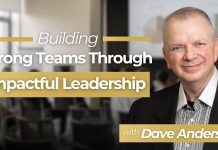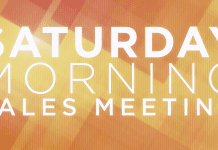On this week’s episode of On the Mark, Mark Tewart talks about how to create more leads, navigating marketing channels as a dealer or manager, and how lead generation equals dollar creation.
VIDEO TRANSCRIPTION:
Mark Tewart: Hi, I’m Mark Tewart, and thanks for joining us this week on On the Mark on CBT News. Today I want to talk to you about lead generation equaling dollar creation, and then I’m going to go into my other two segments, Coach’s Corner and Stop It.
Mark Tewart: Lead generation equals dollar creation. We often talk to salespeople in sales training about how to create more leads, and I’m going to talk to not only salespeople today, but also leaders that are making the decision on your marketing channels. I would like for you to do a little exercise. If you took a plain piece of paper, and in the middle you put a dot, and you were to initial that dot as the name of your company, your dealership, and you were to draw spokes that were going from that dot, there might be 10, 15 spokes or more coming out from the middle, and those spokes represent every way that you get business.
Mark Tewart: So label each one of those spokes. One of them could be walk-in traffic, one of them could be third party internet leads. One of them could be organic leads. One of them could be “be back” business. One of them could be a repeat customer, or service to sales, or subprime, or how do you address what we call factory program updates? If you get an update, do you let your customers know of that update immediately, or potential intenders within your database driving that particular type of vehicle, two, three, four years old, that might update that vehicle? Do you market to your existing customers through email, through calls? Are you looking at different programs that can identify market intenders, people in your marketplace, shopping on Facebook and Google?
Mark Tewart: If you have programs that are available to you that can do that, are you using them? Is that one of the things in the wheelhouse? What about reciprocal agreements with other people, other businesses? You may have insurance, you may have real estate. You may have companies that you’re reciprocally agreeing. It could be restaurants, it could be car washes. It could be anything in your marketplace where you have reciprocal agreements, where you’re rewarding them and they are rewarding you.
Mark Tewart: What about your community activities? Nothing like building a base in your community. It could be with The Humane Center or what are you doing on Facebook? Not just advertising. To give you an example, I have a client that does a phenomenal job with Facebook. They have a lot of connections with The Humane Society in particular, with different organizations. They really have a connection with dog owners. They even have a couple of people at the dealership that daily bring their dogs to work, and they’ve even made national news from this with a dog being in their sales meeting with its paws up on the front of the desk like it was giving the meeting, and they’d began to create a big following from their community activities, the things they’re doing with their dogs. They’re having fun in their Facebook. That’s just different ideas of how you can expand your circle for different spokes.
Mark Tewart: Do you have a trade-in marketplace for you, where you’re identifying people that want to maybe sell their vehicle that you could now get that vehicle? Do you have a service to sales spoke, or you’re able to identify those people that are coming into your drive that would be ready to be able to trade that vehicle, to get a new vehicle, or peak their interest if they have not thought about it? I often flag each particular ticket. If you have a service RO, where it’s projected to be maybe $500 or more, is it automatically being flagged for somebody to speak to that customer, to offer them a free appraisal, for the ability to move on and potentially trade that vehicle and get into a new vehicle?
Mark Tewart: What I’m saying to you is then lead generation equals dollar creation. You will never stop adding spokes and then sub-spokes for each spoke of a way that you get business. This is a continual marketing activity. I would exactly think about each one of those and how we’re proactively reaching our database, whether it’s conventional, whether it’s digital, whether it’s social, and how we can get better at it and keep expanding. When we dwell on one, two or three ways to get traffic, or just one way, one is the worst number in business. You create a diving board business. You go up, you go down, the marketplace changes. Begin to explode the way that you do that spoke and hub system, and add more to it and make it better, and I think you’ll grow your business.
Mark Tewart: And now for my segment Coach’s Corner. Let’s talk about objection handling. I have a little acronym I call BLACKS. And this acronym stands for B, breathe. When you hear an objection, don’t jump on it. Often when salespeople are a little anxious or nervous, or they feel if a deal is going to go south because they got an objection, the first thing you have to understand is that an objection doesn’t mean no. It just means the old adage, “No, not now. I don’t have enough information,” or it’s an opportunity for you to be able to be at the final stage. And that final stage, if you’re at the last objection, it means you can have a customer buying. So the first thing is B, breathe. B stands for breathe. Why? If you take a deep breath, you’re not overreacting to that objection. You’re not giving life to it. You’re simply smiling, you’re taking a deep breath, and you’re thinking about what will come next.
Mark Tewart: Now, the next part of this acronym in BLACKS, B, the next is L. Stands for listening. You have to fully listen to a customer. It is said that when we’re talking to somebody, that if we’re having a conversation, maybe the first 10 seconds we’re really listening, and then we’re thinking about what our reply will be back. And if you’re doing that habitually, you’re not fully listening to somebody. So I invite you to listen completely, get the key words.
Mark Tewart: The next is acknowledge. So I want to acknowledge what somebody says. That’s the A in black. Acknowledge them by saying, “I understand. I appreciate that. Sure. You bet. Be happy to. Fantastic. Boy, that makes sense to me. I hear what you’re saying.” All of those things are acknowledging the customer. Nodding your head slowly, physically leaning in, showing that you’re listening.
Mark Tewart: The next part is C, and C stands for clarify. I want to clarify by asking the customer, “So what I’m hearing you say is …” “What I’m hearing you saying is this.” “Just to clarify, what you said is …” Clarify. That shows that you’re listening and it makes sure that you’re clearly understanding what the customer is saying. It’s not enough to hear. You have to truly understand.
Mark Tewart: And next, the K stands for kick. You have to kick that objection by being able to handle that objection, such as, “I want to think it over. That’s not the right color. That payment’s too high. That down payment is too much.” Whatever that objection is, that’s part of your training that we will go over, you should go over, that you want to make sure that you know how to handle in your best way possible that objection. That’s what I call kicking that objection.
Mark Tewart: And next is S, and S stands for segue. So you’ll want to segue, and the best segue phrase, of all is, “by the way.” So when you get to the end of handling an objection, do not allow that to breathe. Don’t allow air. What I want you to have is a segue. So if I handle an objection such as, “I’ll think it over,” and when I get done, I’m going to say, “Oh, by the way,” and I’ll redirect and ask questions. When you do this properly, when you kick the objection, you segue off, and then you redirect the conversation and you move on, you’re going to find that you’re going to handle very properly most objections you’ll ever have.
Mark Tewart: And now for my segment, Stop It. Stop limiting your dealership with limitations. What I mean by that is, as leaders, we are the leader of the dealership, but you’re a normal human being. So sometimes you get messages from people, from the marketplace, from friends, and you begin to limit yourself on what you can do. And often the biggest limitation you may have is with money. And you’ll say, “I can’t afford this.” Well, let me tell you, very successful people never say, “I can’t afford.” They say, “How can I afford?” There is no lack of money in the world. They’re printing more money today than ever before. So that means value follows money, and it never follows fear.
Mark Tewart: So if you want to do something in your dealership with marketing or anything else that you need money for, stop telling yourself that you don’t have the money, that you can’t afford, and start saying to yourself, “How can I afford?” Ask better questions to get better answers, and realize there is never a limitation on money. You can attract and deliver whatever money that you need for whatever project expenditure and whatever it is that you want to do. Just stop limiting yourself based upon bad statements and questions around the idea of money.
Mark Tewart: I’m Mark Tewart. Thanks so much for joining us on this week’s edition of On the Mark. As always, make sure you check out next week’s show, and always please reach out to me. Email me at info@tewart.com. Call me at 888-2TEWART. You can also go to my website at tewart.com. Check out our in house training, our online training, what we do with our F&I products for dealerships, and the leadership and management workshops that we do. Make sure you communicate with us, tell us what you’re looking for, and let us know how we can assist you. And as always, make sure you check us out next week. Thanks and great selling.
Thanks for watching On the Mark with Mark Tewart. This has been a JBF Business Media Production.





